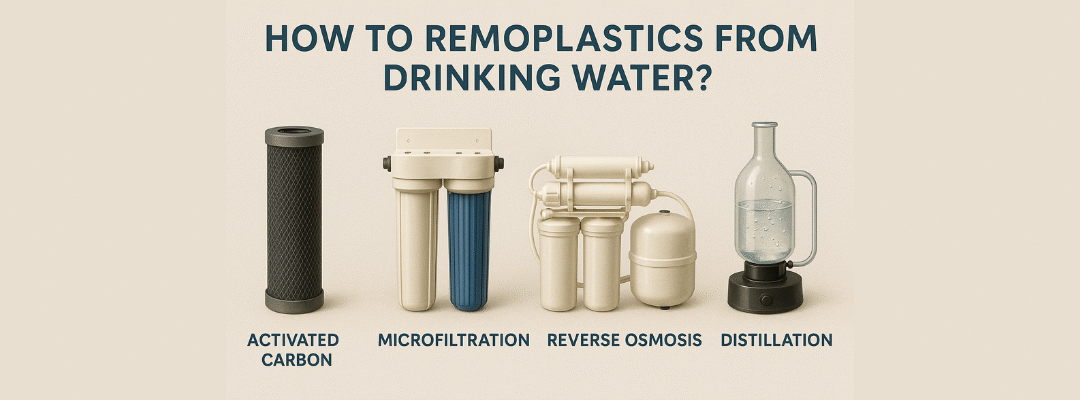Recent studies reveal that microplastics — tiny plastic fragments less than 5 mm in size — are now present even in tap and bottled water. These invisible particles come from plastic waste, fabrics, and industrial runoff, and they’re nearly impossible to detect without lab testing.
If you’re wondering how to remove microplastics from water effectively at home, this guide covers the science, risks, and best filtration methods.
What Are Microplastics?
Microplastics are minute plastic fragments that result from the breakdown of larger plastic materials such as bottles, packaging, and synthetic fabrics.
They are categorized into two types:
- Primary microplastics: Intentionally manufactured small plastics (e.g., exfoliating beads in cosmetics, microfibers from clothes).
- Secondary microplastics: Result from the degradation of larger plastics through sunlight, friction, and environmental exposure.
Common Sources of Microplastics
- Cosmetic and personal-care products
- Industrial waste and manufacturing runoff
- Breakdown of plastic packaging and bottles
- Synthetic clothing (polyester, nylon)
- Plastic plumbing and pipes
How Do Microplastics Enter Drinking Water?
Microplastics can enter household water through several pathways:
- Surface runoff from roads, landfills, and industrial sites
- Leaching from aging plastic plumbing or storage tanks
- Atmospheric deposition, where airborne particles settle in water sources
- Wastewater discharge from washing machines or industrial processes
As a result, both groundwater and municipal supplies can contain measurable microplastic particles.
Why Are Microplastics Dangerous?
Microplastics are not inert; they can absorb and carry toxic chemicals such as pesticides, heavy metals, and additives used in manufacturing.
When consumed regularly, these particles may:
- Enter the digestive tract or bloodstream
- Cause inflammation or oxidative stress
- Affect hormonal balance due to plasticizers like BPA
- Impact gut health and immunity
While research continues, experts agree that reducing exposure is crucial for long-term health protection.
Proven Methods to Remove Microplastics from Drinking Water
1. Ultrafiltration (UF) Systems
How it works:
UF systems use hollow fiber membranes with pore sizes around 0.01 µm, which effectively remove suspended solids, bacteria, and larger microplastic particles.
Best for: Municipal tap water with low TDS levels.
Advantages:
- Operates without electricity
- Low maintenance and cost-effective
Limitations: - Doesn’t remove dissolved salts or very fine contaminants
2. Reverse Osmosis (RO) Purification
How it works:
RO systems force water through a semi-permeable membrane (≈ 0.0001 µm pores), trapping microplastics, heavy metals, dissolved salts, and pathogens.
Best for: Areas with high TDS or mixed contamination.
Advantages:
- Removes up to 99% of microplastics and chemical impurities
- Improves taste, color, and odor
Limitations: - Wastes a small amount of water during purification
RO is the most effective home solution for comprehensive removal of microplastics.
3. Activated Carbon Filters (as a Pre-Filter)
How it works:
Activated carbon adsorbs organic compounds, chlorine, and pesticides, enhancing taste and odor.
Best used with: RO or UF systems for complete filtration.
Advantages:
- Reduces chemical residues
- Inexpensive and easy to install
Limitations: - Ineffective against solid microplastics when used alone
4. Nanofiltration (NF) Systems
How it works:
NF membranes filter organic molecules and tiny suspended particles, making them suitable for industrial and advanced purification setups.
Advantages:
- Removes microplastics smaller than 0.001 µm
- Operates at lower pressure than RO
Best for: Commercial or industrial water purification systems.
5. Boiling and Sedimentation (Temporary Fix)
Boiling water can kill microorganisms, but it does not remove microplastics because they remain suspended after cooling.
Sedimentation can settle some heavier particles, but this method is not reliable as a permanent solution.
Frequently Asked Questions for About Removing Microplastics from Water
1. What are microplastics in drinking water?
Microplastics are tiny plastic particles smaller than 5 millimeters, often invisible to the eye. They enter water sources from synthetic clothing fibers, degraded plastic packaging, industrial waste, and aging plumbing systems.
2. Are microplastics harmful to humans?
Yes. Research indicates that microplastics can carry harmful chemicals and may enter the bloodstream, leading to inflammation, hormonal disruption, and possible digestive or immune system issues. Reducing exposure through filtration is essential for health protection.
3. Can normal water filters remove microplastics?
No. Basic sediment or carbon filters cannot block microplastics because their pores are too large. For effective removal, use RO (Reverse Osmosis) or UF (Ultrafiltration) systems, which filter even microscopic particles.
4. Does a Reverse Osmosis (RO) purifier remove microplastics?
Yes. RO purifiers are the most effective at removing microplastics from drinking water. The semi-permeable membrane (≈0.0001 µm) captures microplastics, heavy metals, and dissolved salts, producing clean, safe, and clear water.
5. Does Ultrafiltration (UF) remove microplastics from tap water?
Yes, UF membranes (≈0.01 µm) effectively remove larger microplastic particles and bacteria from tap or municipal water. However, they may not remove very fine dissolved contaminants like salts or heavy metals.
6. What is the best water purifier to remove microplastics?
A multi-stage water purifier (RO + UF + Activated Carbon) is best for removing microplastics. It filters suspended particles, kills microbes, and adsorbs chemical residues, ensuring safe and pleasant-tasting drinking water.
7. Can boiling or filtering with cloth remove microplastics?
No. Boiling or cloth filtration cannot remove microplastics, as these methods only kill germs or trap large debris. The fine plastic particles remain suspended even after boiling or cooling.
8. How do microplastics get into tap water?
Microplastics enter tap water through surface runoff, sewage leaks, degraded plastic pipelines, and washing synthetic clothes. They also accumulate from environmental pollution and municipal water distribution systems.
9. Are bottled water brands free from microplastics?
Surprisingly, no. Studies have found microplastics in most bottled water brands, often due to the plastic bottles themselves and the bottling process. Installing a home filtration system remains the best way to ensure purity.
10. How can I reduce microplastic exposure at home?
- Use a RO + UF purifier for drinking water.
- Store water in glass or stainless steel bottles.
- Avoid heating food or water in plastic containers.
- Wash synthetic clothes using microfiber-catching filters


Recent Comments